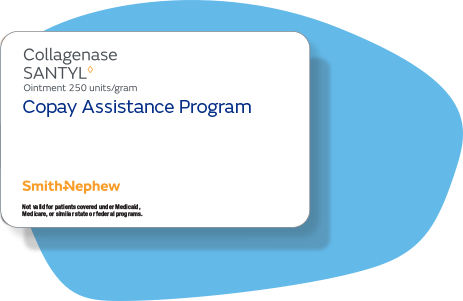Access and save on SANTYL◊ Ointment
Patients who pay more than $50 out of pocket for their prescription, whether they’re insured or not, may be eligible to save with the Copay Assistance Program.
Participants in government healthcare programs or where copay assistance is taxed, restricted, or otherwise prohibited by law are not eligible.
Eligible recipients will pay the first $50; Smith+Nephew will pay the remaining out-of-pocket cost up to the next $250.* The Copay Assistance Card can be used for six prescription fills, up to a $1000 maximum, each year.

Not valid for patients covered under Medicaid, Medicare, or similar state or federal programs. Card is limited to one per person and is not transferable. This card is not health insurance. This offer may be changed or discontinued at any time without notice. Valid at participating pharmacies in the U.S. only, void where taxed, restricted, or prohibited by law.
Not valid for prescriptions eligible to be reimbursed under any government program.
Information on reimbursement in the U.S. is provided as a courtesy. Due to the rapidly changing nature of the law and the Medicare payment policy, and reliance on information provided by outside sources, the information provided herein does not constitute a guarantee or warranty that reimbursement will be received or that the codes identified herein are or will remain applicable. This information is provided “AS IS” and without any other warranty or guarantee, expressed or implied, as to completeness or accuracy, or otherwise.
Providers must confirm or clarify coding and coverage from their respective payers, as each payer may have differing formal or informal coding and coverage policies or decisions. Providers are responsible for accurate documentation of patient conditions and for reporting of products in accordance with particular payer requirements.
How is SANTYL Ointment most commonly reimbursed?
As a service to you and your patients, we have collected a number of reimbursement possibilities for you to consider.
Hospital Outpatient Department (HOPD)/Qualified Healthcare Professional Office (QHP)†
Most commonly, a patient would be given a prescription and would obtain SANTYL Ointment from a retail pharmacy and the patient’s prescription drug benefit would cover and pay for the drug (eg, through commercial insurance, Medicare Part D, or Medicaid).
If the HOPD or QHP provides and uses SANTYL Ointment on the patient during his or her visit, the HOPD or QHP is responsible for the cost of the drug.
Hospital†
Most commonly, the cost of SANTYL Ointment is included in a lump sum payment to the facility from a payer in the form of a Diagnosis Related Group (DRG) or per diem. If, however, the facility is paid based on charges for a patient, SANTYL Ointment may be separately billable.
Home Health Care†
Most commonly, a patient would be given a prescription and would obtain SANTYL Ointment from a retail pharmacy and the patient’s prescription drug benefit would cover and pay for the drug (eg, through commercial insurance, Medicare Part D, or Medicaid).
Nursing Home†
NON-SKILLED: Most commonly, the cost of SANTYL Ointment is covered under the patient’s prescription drug benefit (eg, commercial insurance, Medicare Part D, or Medicaid).
SKILLED: Most commonly, the cost of drugs are covered in a lump sum per diem payment (eg, Resource Utilization Group (RUG) for Medicare or through Medicaid formulary).
† Information on reimbursement in the United States is provided as a courtesy. Due to the rapidly changing nature of the law and Medicare payment policy and the reliance on information provided by outside sources, the information provided herein does not constitute a guarantee or warranty that reimbursement will be received or that the codes identified herein are or will remain applicable.
This information is provided "AS IS" and without any other warranty or guarantee, expressed or implied, as to completeness or accuracy, or otherwise. This information has been compiled based on data gathered from many primary and secondary sources, including the American Medical Association and certain Medicare contractors.
Physicians and other providers must confirm or clarify coding and coverage from their respective payers, as each payer may have differing formal or informal coding and coverage policies or decisions. Physicians and providers are responsible for accurate documentation of patient conditions and for reporting of procedures and products in accordance with particular payer requirements.
The reimbursement information in this section was last verified December 2023.

